The good news? You don’t need a Fortune 500 budget to make a significant impact online. This guide unpacks the most effective digital marketing strategies for small businesses in 2025, focusing on approaches that deliver maximum results without draining your resources.
Whether you’re looking to refine your existing digital presence or building your strategy from scratch, these actionable insights will help position your small business for success in an increasingly competitive digital marketplace.
The State of Digital Marketing for Small Businesses in 2025
The evolving digital marketing landscape for small businesses in 2025
Recent surveys reveal that 49% of small businesses plan to increase their digital marketing budgets in 2025, recognizing the critical role online presence plays in business growth. Yet many still struggle to identify which strategies deserve their limited resources.
The digital marketing landscape has evolved significantly, with several key trends emerging:
- AI tools have democratized access to sophisticated marketing capabilities
- Short-form video content continues to dominate engagement metrics
- Voice search optimization has become essential for local businesses
- Privacy-focused marketing approaches are replacing traditional tracking
- Micro-influencer partnerships offer better ROI than celebrity endorsements
For small businesses, the challenge isn’t just keeping up with these trends but implementing them in ways that align with limited budgets and resources. Let’s explore how you can do exactly that.
AI-Powered Marketing: The Game-Changer for Small Businesses
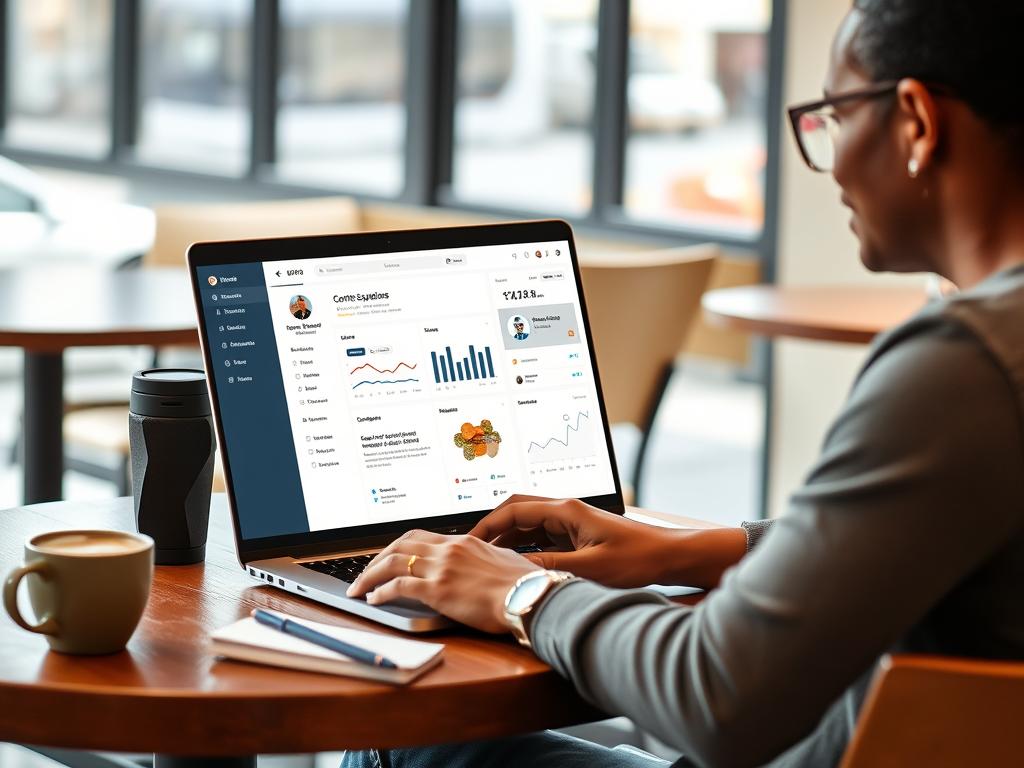
In 2025, AI has transformed from a luxury to a necessity for small business marketing. Nearly 60% of small businesses now use AI tools for their marketing efforts, with content creation (52%) and social media management (39%) being the most common applications.
How Small Businesses Are Leveraging AI in 2025
Content Creation and Optimization
AI tools now generate blog posts, social media captions, and email newsletters that sound authentically human. More importantly, they can analyze top-performing content in your niche and suggest optimizations to improve engagement and search rankings.
Tools like Jasper, Copy.ai, and even ChatGPT Plus offer specialized features for small business content creation, helping you maintain a consistent publishing schedule without sacrificing quality.
Customer Insights and Personalization
AI-powered analytics tools can now identify patterns in customer behavior that would be impossible to spot manually. This allows even the smallest businesses to segment their audience and deliver personalized marketing messages at scale.
Platforms like Klaviyo and ActiveCampaign have integrated AI features that automatically optimize email send times and content based on individual recipient behavior.
Start Using AI in Your Marketing Today
Download our free guide: “AI Marketing Tools for Small Businesses: A Beginner’s Implementation Roadmap” and transform your marketing efficiency in just one week.
Search Engine Optimization: Local SEO Dominance in 2025
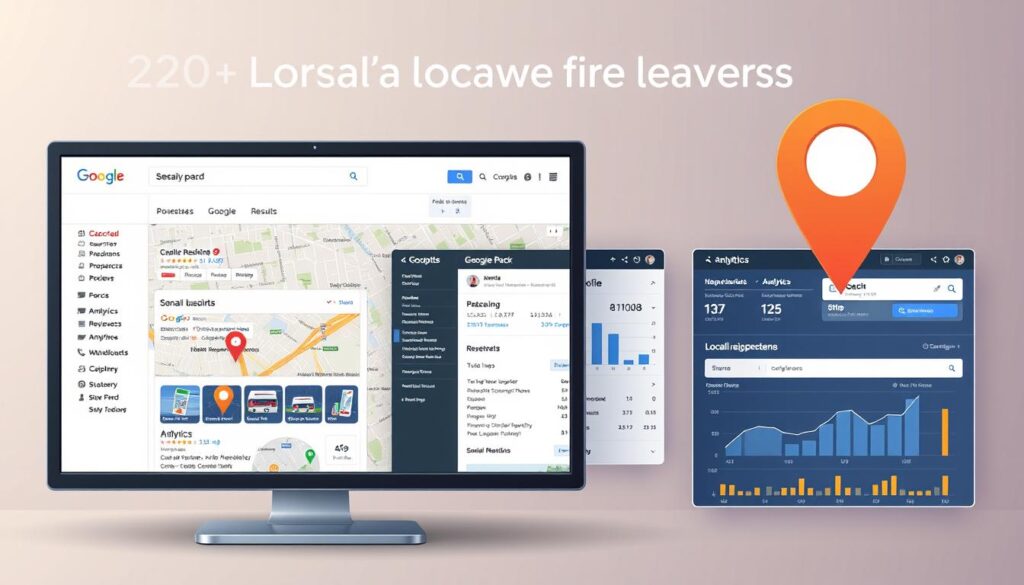
Despite its proven effectiveness, only 39% of small businesses actively invest in SEO. This creates a significant opportunity for those who do, especially in local markets where competition may be less sophisticated.
Local SEO Fundamentals for 2025
Google Business Profile Optimization
In 2025, Google Business Profile (formerly Google My Business) has expanded its features to include more interactive elements. Small businesses should:
- Update business attributes to include new category-specific features
- Respond to all reviews within 24 hours (AI tools can help draft responses)
- Post weekly updates with local keywords naturally incorporated
- Add products and services with detailed descriptions
Neighborhood-Specific Content
Search engines now recognize hyper-local content, making neighborhood-specific keywords valuable for small businesses:
- Create location-specific landing pages for each neighborhood you serve
- Incorporate local landmarks and community references in content
- Develop content addressing neighborhood-specific needs
- Partner with other local businesses for content collaboration and backlinks
Voice Search Optimization
With smart speakers and voice assistants in 65% of American homes in 2025, optimizing for voice search has become essential for local businesses:
Voice Search Optimization Tips
- Structure content to answer specific questions (who, what, when, where, why, how)
- Create FAQ pages using natural, conversational language
- Include phrases people actually speak rather than type
- Ensure your business name, address, and phone number are consistent across all platforms
- Optimize for “near me” searches with location-specific content
Voice Search Mistakes to Avoid
- Using technical jargon that doesn’t match conversational queries
- Ignoring local dialect and regional terms
- Focusing only on short-tail keywords
- Neglecting mobile page speed (voice searches often happen on mobile)
- Forgetting to claim and verify all local business listings
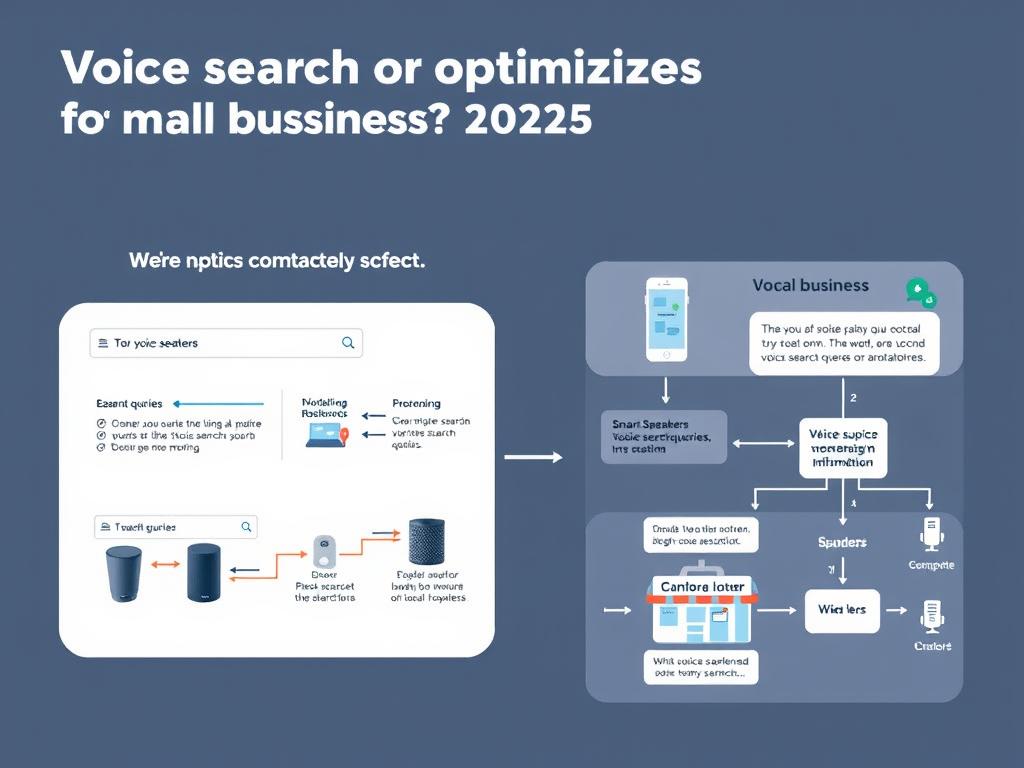
How voice search queries differ from traditional text searches
Email Marketing: Personalization at Scale
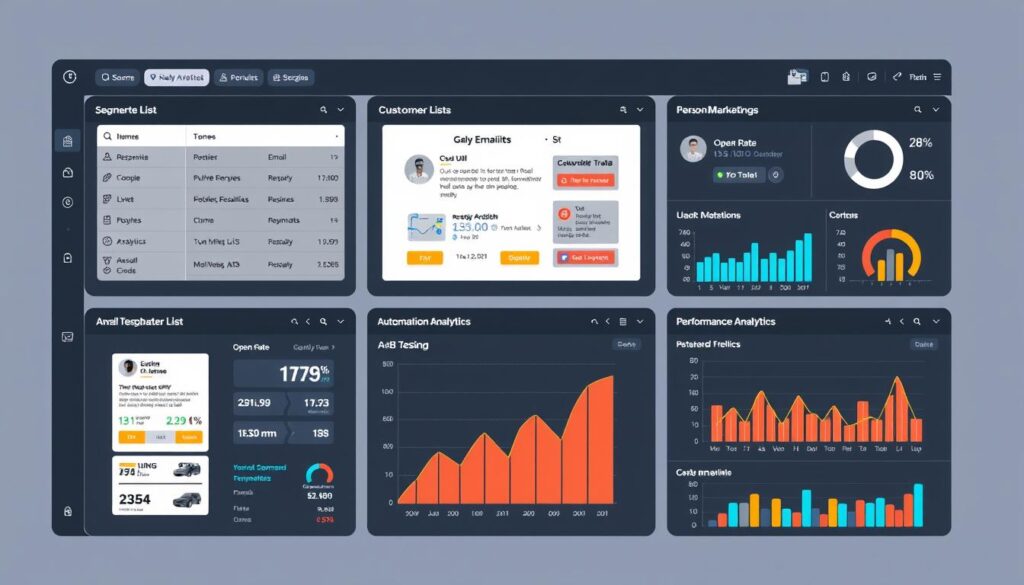
Email marketing continues to deliver the highest ROI of any digital channel, with an average return of $42 for every $1 spent. For small businesses in 2025, the key differentiator is the level of personalization and automation implemented.
Advanced Personalization Strategies
Gone are the days when adding a first name to an email was considered personalization. In 2025, small businesses are leveraging behavioral data and AI to create truly personalized experiences:
Behavioral Triggers
Set up automated emails based on specific customer actions:
- Browse abandonment (viewed product but didn’t add to cart)
- Cart abandonment (added to cart but didn’t purchase)
- Post-purchase sequences based on what was bought
- Re-engagement campaigns for inactive subscribers
Dynamic Content
Create emails that change based on subscriber data:
- Location-specific offers and information
- Product recommendations based on past purchases
- Weather-triggered promotions
- Content tailored to industry or job role (for B2B)
Segmentation Strategies
Divide your list for more relevant messaging:
- Purchase history and average order value
- Engagement level (opens, clicks, website visits)
- Content preferences and interests
- Customer lifecycle stage
Email Automation Workflows for Small Businesses
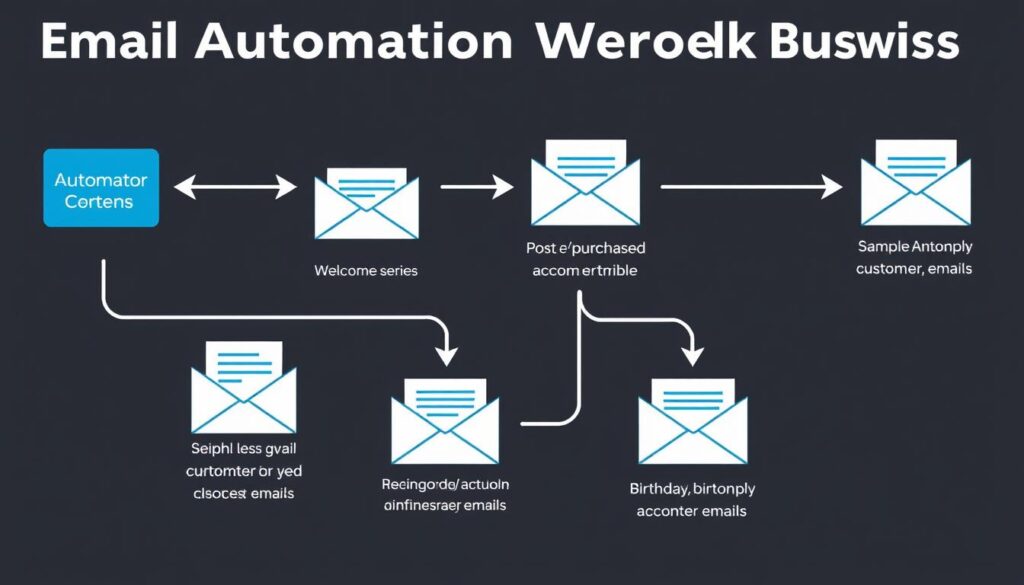
Essential email automation workflows for small businesses
The most successful small businesses in 2025 have implemented these core automation workflows:
- Welcome Series: A 3-5 email sequence introducing new subscribers to your brand, products/services, and unique value proposition.
- Abandoned Cart: A sequence of 2-3 emails reminding customers about products left in their cart, often including incentives in later emails.
- Post-Purchase: A series of emails that guide customers through onboarding, provide usage tips, request reviews, and suggest complementary products.
- Re-Engagement: A campaign targeting subscribers who haven’t opened emails in 60-90 days, aiming to win them back or clean your list.
- Birthday/Anniversary: Automated emails celebrating customer milestones with special offers or recognition.
“The most effective email marketing strategies for small businesses in 2025 combine the personal touch that small businesses are known for with the power of automation and data-driven personalization.”
Content Marketing: Quality Over Quantity
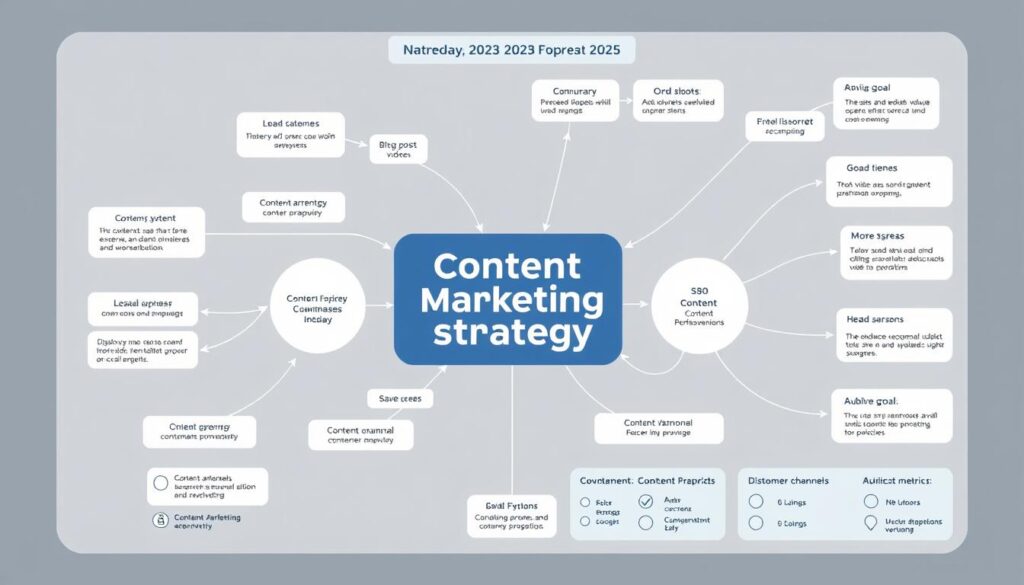
In 2025, content marketing has shifted dramatically for small businesses. With AI-generated content flooding the internet, search engines and social platforms have adjusted their algorithms to prioritize demonstrable expertise, authenticity, and unique insights.
The E-E-A-T Principle for Small Business Content
Google’s E-E-A-T guidelines (Experience, Expertise, Authoritativeness, and Trustworthiness) have become central to content strategy:
Showcasing Experience
Small businesses have a unique advantage in demonstrating first-hand experience:
- Share case studies from your actual clients
- Document your process with behind-the-scenes content
- Include specific details that only someone with hands-on experience would know
- Use “we’ve found that…” statements based on your business experience
Building Authority
Establish your business as an authority in your niche:
- Create in-depth guides that showcase your specialized knowledge
- Publish original research or surveys relevant to your industry
- Secure guest posting opportunities on respected industry websites
- Participate in podcast interviews and webinars as an expert guest
Content Formats That Perform in 2025
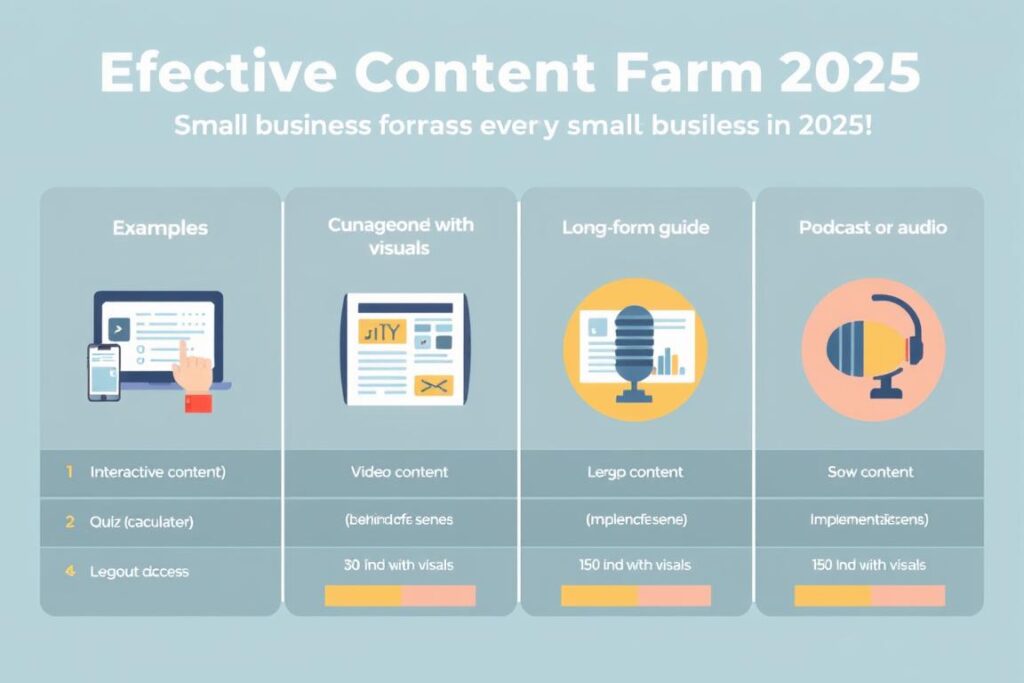
Performance comparison of different content formats for small businesses
Interactive Content
Engagement rates for interactive content are 2x higher than static content:
- Calculators relevant to your industry
- Quizzes that help customers identify their needs
- Interactive decision trees
- Assessments with personalized results
Video Content
Video remains crucial but has evolved in format:
- Short-form educational videos (under 60 seconds)
- Live streaming product demonstrations
- Customer testimonial videos
- Process videos showing how products are made
Audio Content
Audio content continues to grow in popularity:
- Mini-podcasts (5-15 minutes)
- Audio versions of blog posts
- Industry interview series
- Audio newsletters
Create Your Content Marketing Strategy
Download our “Small Business Content Calendar Template” with 52 weeks of content ideas specifically designed for small businesses in 2025.
Paid Advertising: Targeted Approaches for Maximum ROI
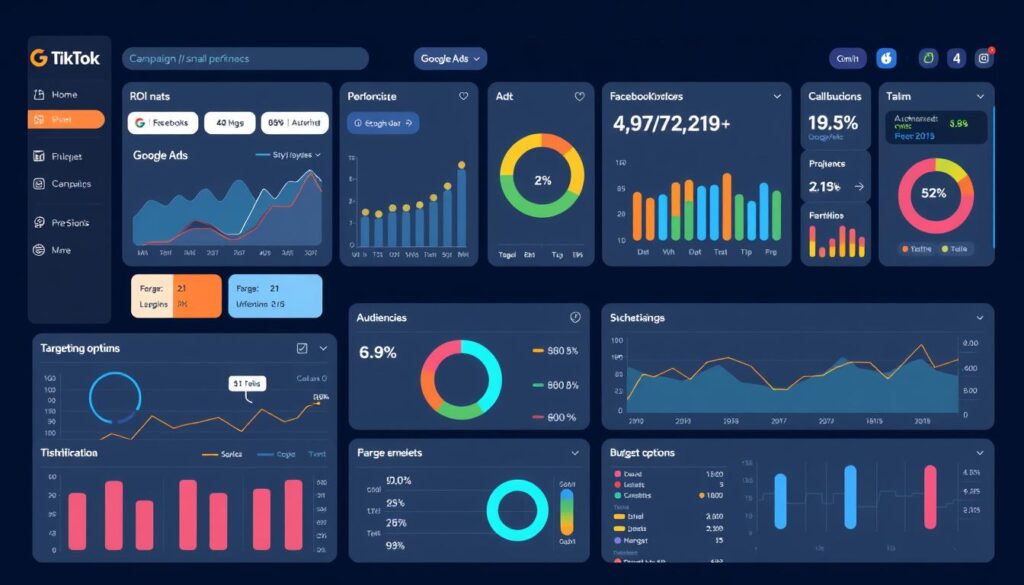
Paid advertising remains essential for small businesses, with search advertising (40%) and social media ads (47%) being the most popular channels. However, the approach to paid advertising has evolved significantly in 2025.
Platform-Specific Advertising Strategies
| Platform | Best Ad Formats | Targeting Options | Average Cost | Best For |
| Google Ads | Local Service Ads, Performance Max | Search intent, location, demographics | $2-5 per click | Capturing high-intent customers |
| Meta (Facebook/Instagram) | Reels ads, Shop ads, Stories | Interests, behaviors, lookalike audiences | $0.50-2 per click | Brand awareness, community building |
| TikTok | In-feed ads, Spark Ads | Interests, behaviors, engagement | $1-2 per click | Reaching younger demographics |
| Sponsored content, Message ads | Job title, company size, industry | $5-7 per click | B2B lead generation |
Budget Allocation Strategies for Small Businesses
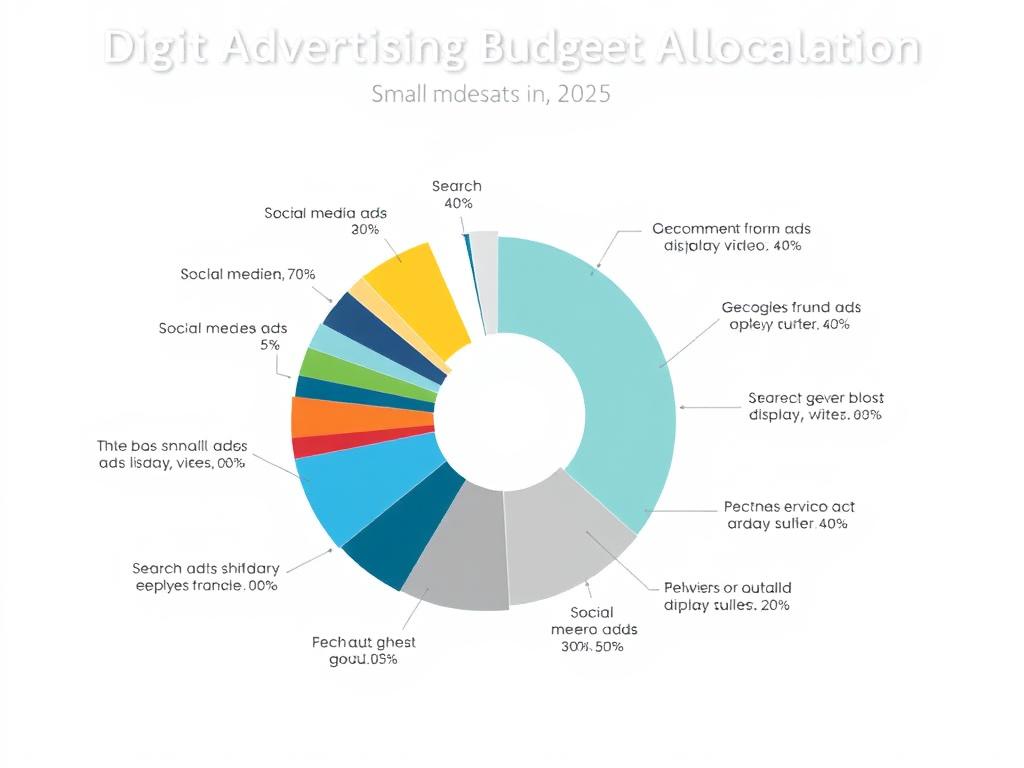
Recommended advertising budget allocation for small businesses in 2025
For small businesses with limited budgets, strategic allocation is crucial:
The 70/20/10 Rule
A practical framework for small business ad spend:
- 70% to channels and campaigns with proven ROI
- 20% to scaling promising new campaigns
- 10% to testing completely new platforms or approaches
This balanced approach ensures stability while allowing for innovation and growth.
Micro-Testing Strategy
Before committing significant budget:
- Run small tests ($50-100) across multiple platforms
- Test different audience segments with minimal creative variations
- Analyze results after reaching statistical significance
- Scale only the top-performing combinations
This approach minimizes risk while maximizing learning and ROI.
Pro Tip: In 2025, the most successful small businesses are combining paid advertising with organic content strategies. For example, repurposing high-performing organic social posts as ads typically results in 30-40% higher engagement rates and lower costs per click.
Marketing Automation: Efficiency for Small Teams
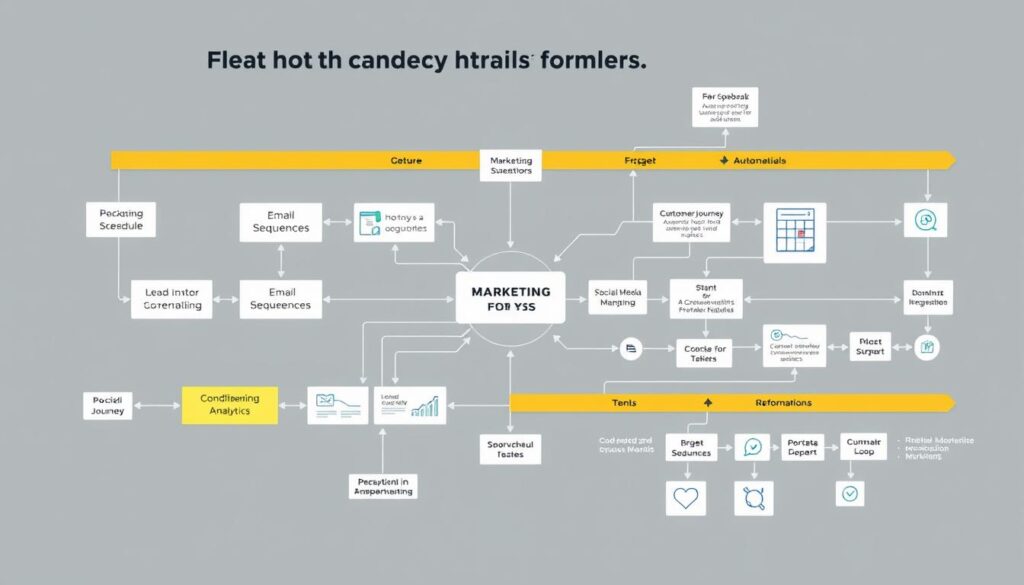
For small businesses with limited staff, marketing automation has become essential rather than optional. In 2025, 73% of small businesses use at least one automation tool, with the average being 2-3 platforms integrated together.
Essential Automation Workflows for Small Businesses
Lead Nurturing
Automatically guide prospects through your sales funnel:
- Welcome sequences for new leads
- Educational content based on expressed interests
- Follow-up sequences after content downloads
- Sales meeting scheduling automation
Customer Onboarding
Streamline the experience for new customers:
- Product/service usage tutorials
- Automated check-ins at key milestones
- Feedback collection at strategic points
- Cross-sell recommendations based on purchases
Social Media Management
Maintain consistent presence without daily manual work:
- Content calendar scheduling across platforms
- Automated responses to common questions
- Content recycling for evergreen posts
- Performance reporting and analytics
Affordable Automation Tools for Small Businesses
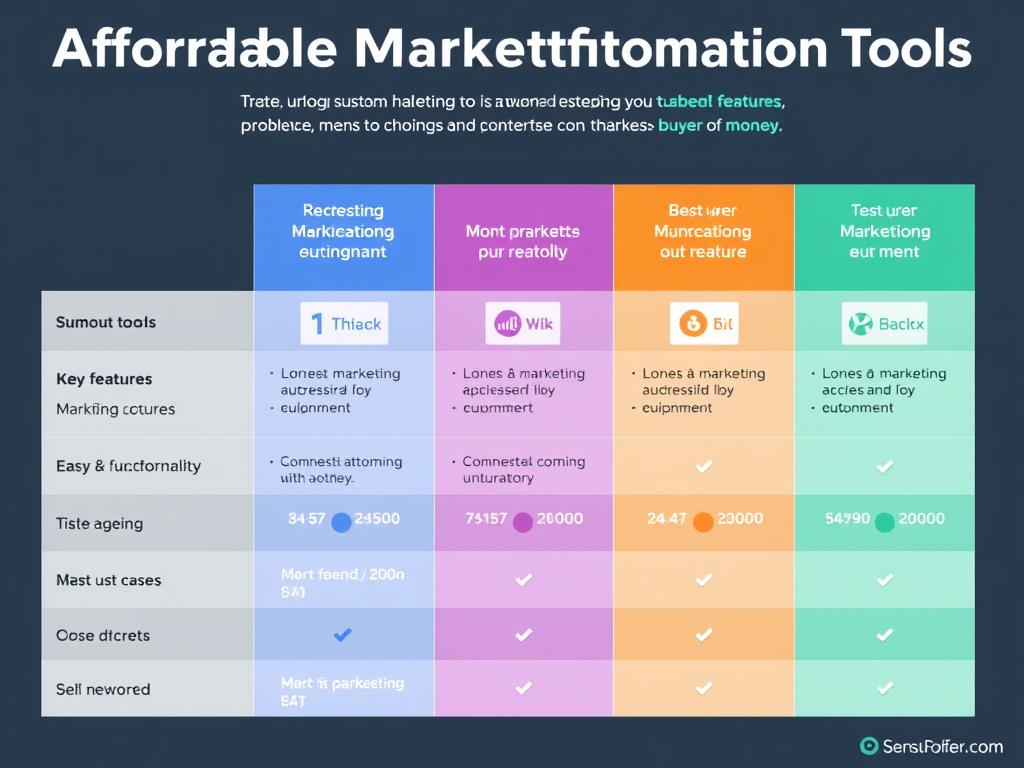
Comparison of top marketing automation platforms for small businesses
These affordable tools offer powerful automation capabilities without enterprise-level pricing:
| Tool | Best For | Starting Price | Key Features |
| ActiveCampaign | Email marketing, CRM, sales automation | $29/month | Visual automation builder, predictive sending, site tracking |
| Zapier | Connecting different apps and tools | Free (limited), $19.99/month | 5,000+ app integrations, multi-step zaps, filters and conditions |
| HubSpot Starter | All-in-one marketing platform | $45/month | Email marketing, forms, landing pages, live chat |
| SendinBlue | Email and SMS marketing | Free (limited), $25/month | Email automation, SMS marketing, landing pages |
Real-World Success: Small Business Digital Marketing Case Studies

Local Bakery Increases Revenue by 35%
Challenge: A neighborhood bakery was struggling to compete with larger chains and saw declining foot traffic.
Strategy: Implemented a three-pronged approach:
- Created a Google Business Profile with weekly updates and actively managed reviews
- Developed a simple email program offering a free pastry on customers’ birthdays
- Posted daily “fresh out of the oven” content on Instagram and TikTok
Results: 35% revenue increase within 6 months, 150% growth in Instagram followers, and a 22% increase in repeat customers.

Home Service Business Doubles Leads
Challenge: A local plumbing company was spending too much on traditional advertising with diminishing returns.
Strategy: Shifted budget to digital channels:
- Invested in Google Local Service Ads and targeted search campaigns
- Created how-to videos addressing common plumbing issues
- Implemented a review generation system with automated follow-ups
Results: 110% increase in qualified leads, 40% reduction in overall marketing costs, and improved close rate from 20% to 35%.
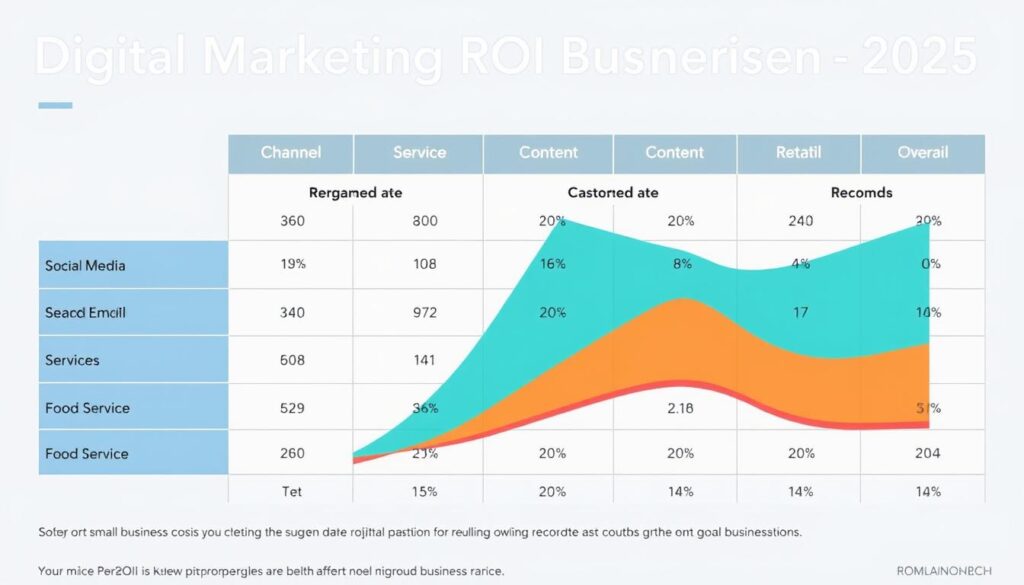
Digital marketing ROI comparison across different small business types
“The most successful small businesses in 2025 aren’t trying to compete with large corporations by mimicking their strategies. Instead, they’re leveraging their unique advantages: agility, authenticity, and deep community connections.”
Your 90-Day Implementation Roadmap
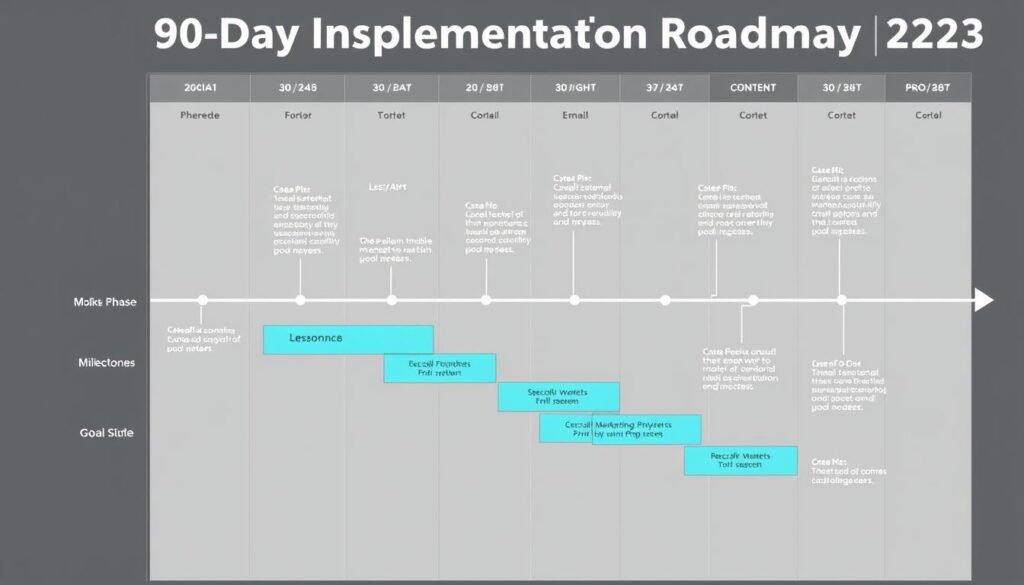
Implementing a comprehensive digital marketing strategy can feel overwhelming. This 90-day roadmap breaks the process into manageable phases:
Days 1-30: Foundation
- Audit your current digital presence and analytics setup
- Claim and optimize Google Business Profile and online directories
- Set up or refine social media profiles on 2-3 priority platforms
- Implement basic email collection on your website
- Create a content calendar for the next 30 days
Key Milestone: Complete digital presence audit and establish baseline metrics.
Days 31-60: Growth
- Launch your first automated email sequence
- Begin testing paid advertising on one platform
- Create and publish 2-4 pieces of high-quality content
- Implement one AI tool to improve efficiency
- Start actively soliciting and managing reviews
Key Milestone: First automated marketing system fully operational.
Days 61-90: Optimization
- Analyze results and refine strategies based on data
- Scale successful paid advertising campaigns
- Implement additional automation workflows
- Develop a referral or loyalty program
- Create a 6-month content and marketing plan
Key Milestone: Data-driven optimization process established.
Ready to Implement Your Digital Marketing Strategy?
Download our comprehensive “Digital Marketing Strategy Template for Small Businesses 2025” with step-by-step implementation guides, budget calculators, and customizable planning tools.
Conclusion: The Small Business Digital Advantage
As we’ve explored throughout this guide, digital marketing in 2025 offers unprecedented opportunities for small businesses to compete effectively against larger competitors. The key is leveraging your inherent advantages—authenticity, agility, and community connection—while strategically implementing the digital tactics that align with your specific business goals and resources.
Remember that you don’t need to implement every strategy at once. Start with the foundations, measure your results, and gradually expand your digital marketing efforts based on what works for your unique business. The most successful small businesses in 2025 aren’t necessarily those with the biggest budgets, but those who consistently apply these strategies with creativity and persistence.
By focusing on the strategies outlined in this guide—from AI-powered marketing and social media to search optimization and email personalization—you’ll be well-positioned to grow your small business in an increasingly digital marketplace.

With the right digital marketing strategies, small businesses can achieve remarkable growth in 2025
What digital marketing strategy gives the best ROI for small businesses in 2025?
Email marketing consistently delivers the highest ROI (approximately $42 for every $1 spent), followed closely by search engine optimization and paid search advertising. However, the best strategy varies based on your specific business, industry, and target audience. Most successful small businesses use a combination of these channels rather than relying on just one.
How much should a small business spend on digital marketing in 2025?
Most successful small businesses allocate 7-12% of their revenue to marketing, with 60-70% of that going to digital channels. However, this varies by industry and growth stage. Startups and businesses in competitive industries may need to invest more (12-20%), while established businesses in less competitive markets might succeed with 5-7%.
Can AI really help small businesses with limited marketing budgets?
Absolutely. AI tools have democratized access to sophisticated marketing capabilities that were previously available only to large enterprises. Small businesses can now leverage AI for content creation, customer segmentation, ad optimization, and personalization at a fraction of the traditional cost. Many effective AI marketing tools offer free or low-cost tiers specifically designed for small business budgets.
Start Implementing These Strategies Today
Get our complete “Digital Marketing Strategies for Small Businesses 2025” implementation guide with templates, checklists, and step-by-step instructions.


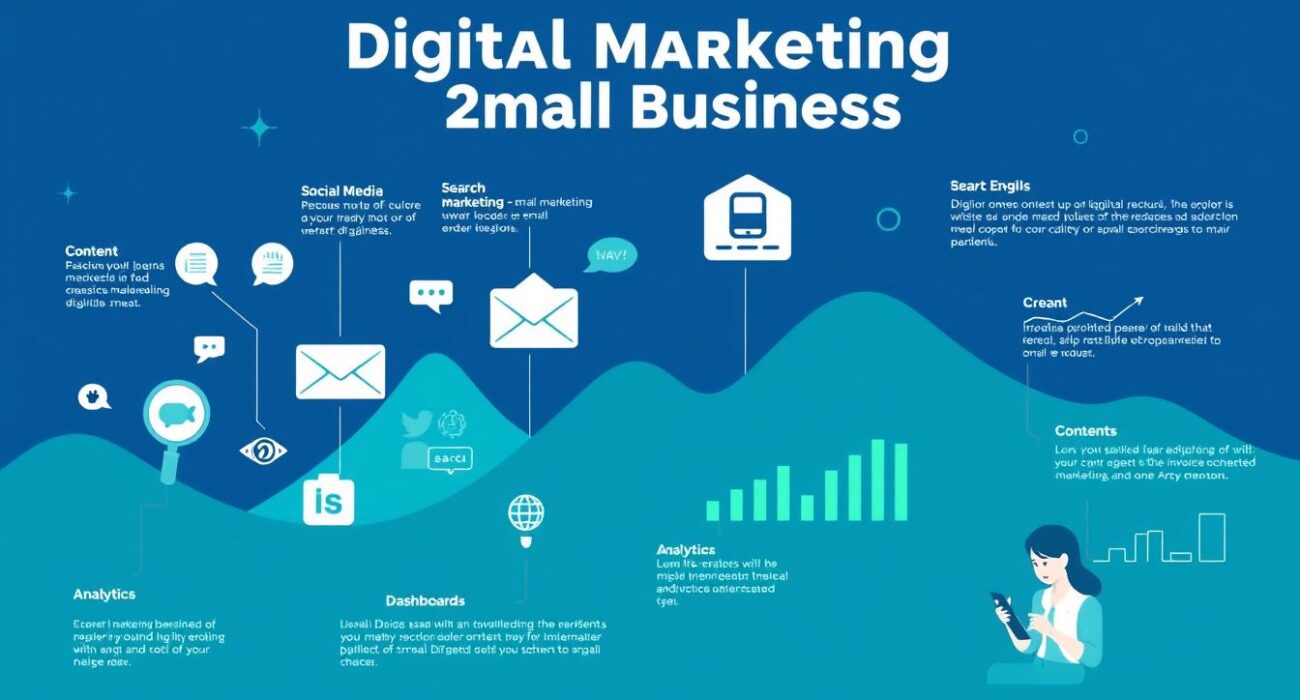
Social Media Marketing Strategies That Actually Work in 2025
Social media remains the most widely used digital marketing channel for small businesses, with 52% using unpaid social media marketing and 47% investing in social media ads. However, the landscape has changed dramatically from previous years.
Platform-Specific Strategies for 2025
TikTok & Instagram Reels
Short-form video now drives the highest engagement across platforms. In 2025, successful small businesses are creating authentic, behind-the-scenes content that showcases their personality and process rather than polished advertisements.
Pro Tip: Use the “day in the life” format to showcase your business operations. These videos typically see 2-3x higher engagement than promotional content.
LinkedIn & Facebook
These platforms have evolved into community-building tools rather than just promotional channels. Successful small businesses use them to host discussions, share industry insights, and position themselves as thought leaders.
Pro Tip: Create a weekly “Ask Me Anything” thread to encourage customer questions and showcase your expertise.
Emerging Platforms
Platforms like Threads and BeReal are gaining traction among younger demographics. While they may not drive immediate sales, establishing an early presence can position your business advantageously as these platforms mature.
Pro Tip: Allocate 10% of your social media time to experimenting with emerging platforms to stay ahead of competitors.
Content Strategy for Small Business Social Media
Example of a balanced social media content calendar for small businesses